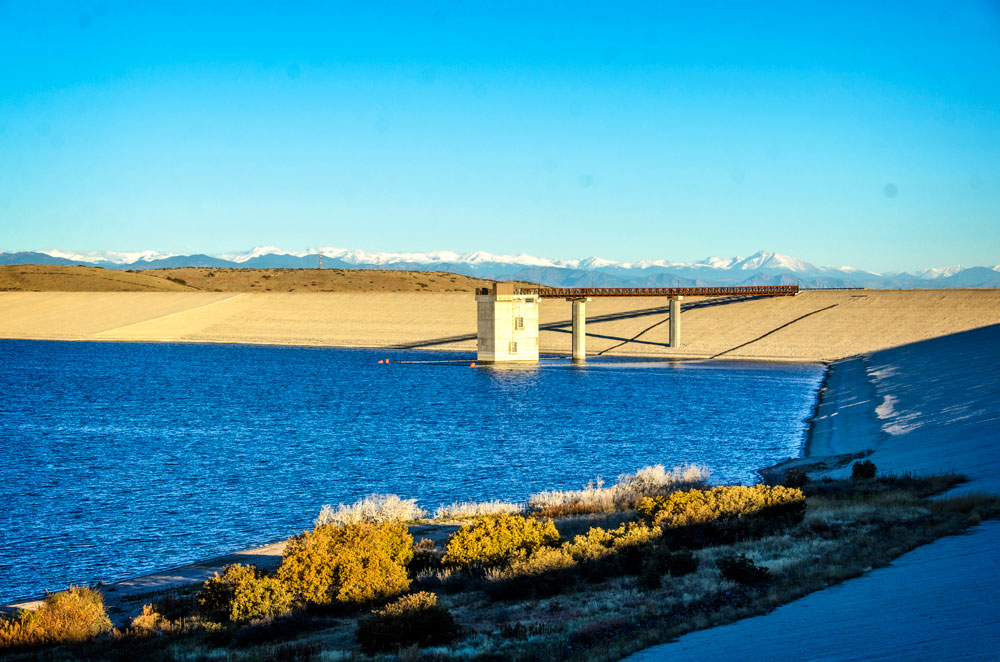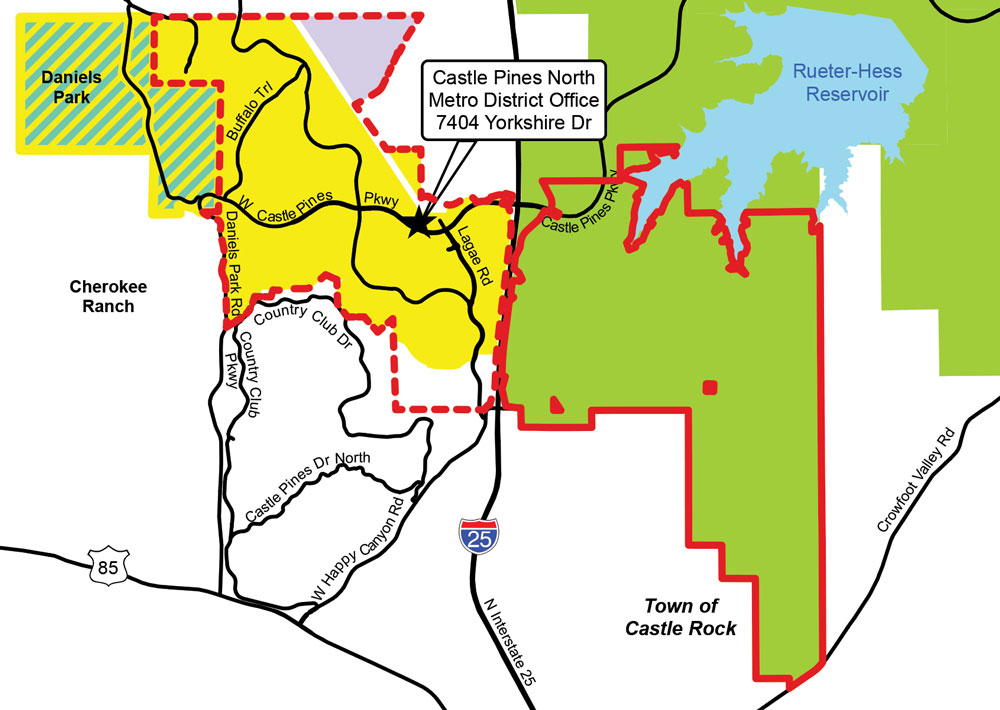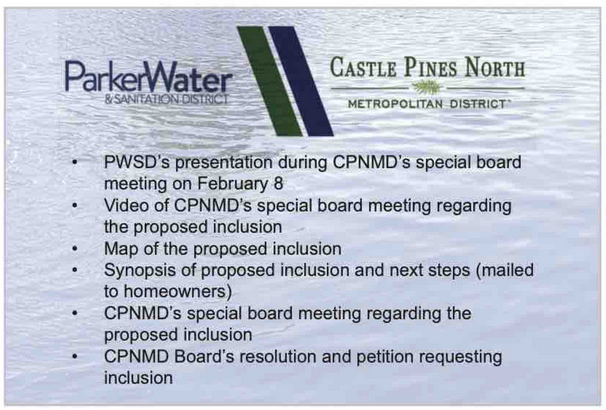Voters to decide on water district inclusion proposal
By Chris Michlewicz; photo and graphic courtesy of Castle Pines Metropolitan District

This spring, voters in the Castle Pines North Metropolitan District will consider whether to approve an inclusion agreement with the Parker Water & Sanitation District (PWSD). If approved, PWSD will take over water and sewer service on the west side of the City of Castle Pines and CPNMD’s assets will be transferred over.
Water and sewer customers in Castle Pines will soon decide whether to approve the proposed inclusion of the Castle Pines North Metropolitan District (CPNMD) into the Parker Water & Sanitation District (PWSD).
The neighboring entities first began discussing the subject of inclusion in December 2018 and have spent the last two years conducting a wide-ranging feasibility study on potential costs and required projects to physically and administratively connect the districts.
Although a district water court judge has not yet set the official date for the mail-in ballot election, the CPNMD is eyeing May 4 as the final date for ballots to be turned in. Ballots would arrive in the mail about three weeks prior to the official election date.
Results of the inclusion feasibility study – conducted jointly by both districts – were distributed in a 16-page synopsis of the proposed inclusion mailed to all CPNMD customers in January.
The inclusion proposal comes on the heels of failed CPNMD ballot measures in 2016 and 2018 to fund renewable water projects that would have cost $120 million and $103 million respectively to secure roughly 50% of the renewable water needed to serve CPNMD customers.
A change in CPNMD’s leadership, including CPNMD directors, led to the latest proposal, which both water providers are hailing as a win-win for each district.
“I was elected on a platform that offered one thing only: we would attempt to secure more renewable water for less money (than previously proposed),” said David McEntire, president of the CPNMD.
McEntire said consolidating services with a larger, well-established water district – especially one that built and owns Rueter-Hess Reservoir and possesses water rights throughout the Front Range – is a move that would solidify a reliable renewable water supply, improve efficiencies, decrease property taxes, and, according to the feasibility study, reduce monthly bills for 96% of CPNMD’s existing customers.
Conditions of the proposed inclusion, if approved by CPNMD voters, include the conveyance of all of CPNMD’s assets to PWSD, including water rights, utility infrastructure and $34.8 million in cash reserves that would be left after CPNMD pays all of its debts. Existing agreements, including CPNMD’s contract with Centennial Water, would be left intact. The boards of directors for both CPNMD and PWSD have approved moving forward with the inclusion agreement, but CPNMD customers will have the final say.
Inclusion would mean 75% of the renewable water needed to supply Castle Pines at full build-out would be secured, with immediate out-of-pocket costs to CPNMD constituents being zero, McEntire said. Water and sewer rates would increase about 2.75% annually through 2029, and 3% thereafter.

Geography of the proposed inclusion (outlined in red dotted line) of the Castle Pines North Metropolitan District’s water and wastewater utilities with those of the Parker Water & Sanitation District (PWSD). Water services on the east side of I-25 are already provided by PWSD (outlined in solid red line).
In the coming weeks, the water district court will determine if CPNMD can legally go to a vote for inclusion because, as McEntire pointed out, such a process has never been done before. The inclusion, if approved by voters, would go into effect on January 3, 2022.
A portion of the cash transferred to PWSD would be used to connect the water and sanitation systems; for example, an 18-inch pipeline measuring about two miles in length would be installed along the Hess Road corridor east of I-25. A pump station will be built near I-25, and piping under the highway would be required.
Additionally, approximately $6.4 million of the $38.4 million transferred to PWSD would be a “makeup payment” to bring CPNMD to the same level of investment that Parker residents have already made in, for example, water rights in Logan County and facilities like the water purification plant on Hess Road near Rueter-Hess Reservoir. CPNMD currently owns 1,500 acre-feet of raw water storage in the reservoir. According to McEntire, if voters approve the proposed inclusion, CPNMD’s customers would become equal co-owners, along with every other PWSD customer, of Rueter-Hess Reservoir and its 75,000 acre-feet of storage capacity. A study to assess the condition of CPNMD’s infrastructure and determine current and future maintenance costs was also considered in the inclusion feasibility study.
Steve Hellman, chief financial officer for PWSD, said during a February 8 presentation to the CPNMD board of directors that the inclusion study looked at both districts’ water rights, existing and future water demands, assets, liabilities and debts, as well as the goals and objectives of both districts’ boards. The study found “no gamestoppers” that would cause either side to reconsider the proposed inclusion, Hellman said.
CPNMD has posted a water and wastewater bill calculator on its website. The online tool enables CPNMD residential customers to calculate their total estimated monthly bill for water and sewer services. For assistance with the bill calculator, call 303-688-8550. Voters seeking additional information about the inclusion agreement may visit the CPNMD website at https://cpnmd.org/ and click on the PWSD/CPNMD logo (pictured below), or visit the PWSD website at www.pwsd.org. Some documents available include: